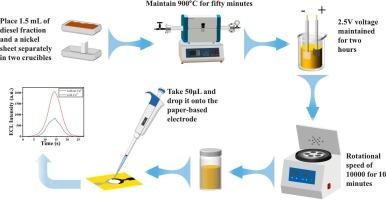柴油馏分制备石墨烯量子点及其在铜离子电化学发光检测中的应用
IF 4.1
3区 化学
Q1 CHEMISTRY, ANALYTICAL
引用次数: 0
摘要
为了实现柴油馏分的高附加值利用,本研究采用化学气相沉积(CVD)技术,以工业废柴油馏分为碳源,在镍基上沉积碳膜。随后,通过电化学剥离法合成了石墨烯量子点(GQDs),并对其在铜离子检测中的应用进行了探索。该方法制备的GQDs具有均匀的尺寸和优良的荧光特性。此外,该方法将CVD生长高质量碳膜的优势与电化学剥离的绿色可控特性相结合,在对环境影响最小的情况下实现高效合成。这为柴油馏分的高价值利用提供了一种新的绿色解决方案。利用紫外可见光谱(UV-Vis)、光致发光光谱(PL)和透射电子显微镜(TEM)对所制备的GQDs进行了表征,显示出优异的光学性能和稳定的荧光响应。以GQDs为底物,K₂S₂O₈为共试剂,研制了一种检测Cu2+的纸基电化学发光(ECL)传感器。传感器的探测范围为0.01 ~ 1000 μM。实验结果证实,随着Cu2+浓度的增加,ECL响应发生了显著变化,从而实现了有效的检测。该研究不仅展示了一种创新的柴油组分废弃物作为GQDs碳前体的回收途径,而且为铜离子检测和生物分析应用提供了一个敏感和选择性的ECL传感平台。本文章由计算机程序翻译,如有差异,请以英文原文为准。

Synthesis of graphene quantum dots from diesel fractions and the application in electrochemiluminescence detection of copper ions
To achieve high value-added utilization of diesel fractions, this study employs chemical vapor deposition (CVD) technology, utilizing industrial waste diesel fractions as a carbon source, to deposit carbon films on nickel substrates. Subsequently, graphene quantum dots (GQDs) are synthesized via electrochemical exfoliation, and their application in copper ion detection is explored. The GQDs prepared through this method exhibit uniform size and excellent fluorescence properties. Additionally, this method combines the advantages of CVD in growing high-quality carbon films with the green and controllable characteristics of electrochemical exfoliation, achieving efficient synthesis with minimal environmental impact. This provides a novel green solution for the high-value utilization of diesel fractions. The obtained GQDs were characterized using ultraviolet-visible spectroscopy (UV–Vis), photoluminescence (PL) spectroscopy, and transmission electron microscopy (TEM), demonstrating excellent optical properties and stable fluorescence response. A paper-based electrochemical luminescence (ECL) sensor using GQDs as the substrate and K₂S₂O₈ as the co-reagent was developed for Cu2+ detection. The sensor exhibits a detection range of 0.01–1000 μM. Experimental results confirm that the ECL response undergoes significant changes with increasing Cu2+ concentration, enabling effective detection. This study not only demonstrates an innovative recycling pathway for diesel component waste as a carbon precursor for GQDs but also provides a sensitive and selective ECL sensing platform for copper ion detection and bioanalytical applications.
求助全文
通过发布文献求助,成功后即可免费获取论文全文。
去求助
来源期刊
CiteScore
7.80
自引率
6.70%
发文量
912
审稿时长
2.4 months
期刊介绍:
The Journal of Electroanalytical Chemistry is the foremost international journal devoted to the interdisciplinary subject of electrochemistry in all its aspects, theoretical as well as applied.
Electrochemistry is a wide ranging area that is in a state of continuous evolution. Rather than compiling a long list of topics covered by the Journal, the editors would like to draw particular attention to the key issues of novelty, topicality and quality. Papers should present new and interesting electrochemical science in a way that is accessible to the reader. The presentation and discussion should be at a level that is consistent with the international status of the Journal. Reports describing the application of well-established techniques to problems that are essentially technical will not be accepted. Similarly, papers that report observations but fail to provide adequate interpretation will be rejected by the Editors. Papers dealing with technical electrochemistry should be submitted to other specialist journals unless the authors can show that their work provides substantially new insights into electrochemical processes.

 求助内容:
求助内容: 应助结果提醒方式:
应助结果提醒方式:


